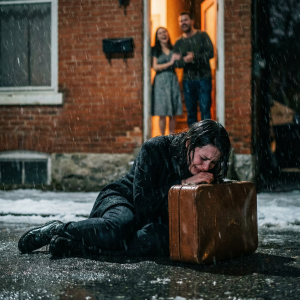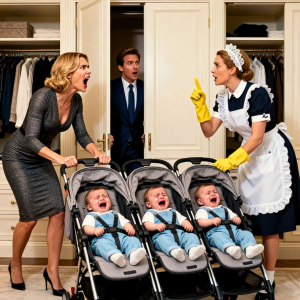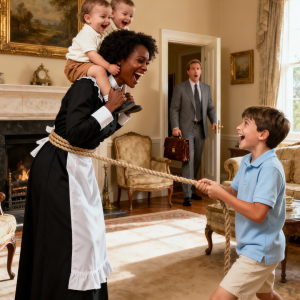
After her mother’s funeral, Claire Whitman walked out of the church with little more than a worn canvas tucked beneath her arm. Her sister, Rebecca, left with the keys to three summer houses along the coast. Relatives whispered about fairness, about what counted as real inheritance. Rebecca smiled through her tears, already calculating what she could sell. Claire only carried the painting, her mother’s favorite, though the frame was cracked and the varnish yellowed.
That evening her husband, Cole, stared at the painting with contempt. He ripped it off the wall and let it crash against her feet. “That old thing? Your sister got estates, and you got trash. You two are made for each other.” He stormed out, leaving Claire crouched over the broken frame, palms trembling. She didn’t say a word, but she kept the painting safe, as if guarding something more fragile than canvas.
Weeks passed. Claire worked in a small art restoration studio in New York. She studied the painting late at night, gently lifting layers of grime. One evening, while adjusting a lamp, she noticed the brushwork beneath the surface—strong, unfamiliar, almost defiant. She cleaned more, and her breath caught. This wasn’t her mother’s simple landscape. It was the underpainting of a lost work by Samuel Garrison, a nineteenth-century American painter whose “First Dawn” had vanished decades earlier.
Claire brought the discovery to Mr. Whitaker, the director of the Metropolitan Art Museum. He examined it under UV light and leaned back, silent. Finally he said, “Mrs. Whitman, do you understand what you’ve brought me? This is history. This is priceless.”

The museum organized a special exhibition. On the opening night, journalists filled the hall. The covered canvas waited on the stage. When it was unveiled, the audience gasped as though breathing with one voice. Applause thundered, cameras flashed, and Mr. Whitaker wiped tears from his eyes. Claire stepped aside, letting the painting shine on its own.
When the applause eased, she took the microphone. Her voice was steady. “My mother gave me this painting. It seemed small compared to what my sister received, but it carried something greater: her trust. Tonight, I return this work not as an owner, but as a daughter finishing what she began.” She turned toward Whitaker. “On behalf of my family, I return ‘First Dawn’ to the Garrison legacy.”
Applause shook the room again. But Claire wasn’t finished. She glanced toward the far corner, where Rebecca stood with Cole. Their faces were pale, their eyes darting like trapped animals.
Claire’s tone cooled. “But you should know the cost of this moment.” She gestured backstage. The giant screen lit up with Rebecca’s posts: accusations that Claire was unstable, that she’d stolen an heirloom, pleas for sympathy from “a betrayed sister.” Murmurs rippled through the hall.
The next slide showed Cole’s reposts, calling Claire delusional, hinting she was unfit to inherit. Then came private messages: “We need to push that she’s losing it. Collect every odd thing she’s ever done. Once people see her as unstable, we can contest the will.”
The audience erupted. Gasps, whispers, indignation swelling to open outrage. Claire didn’t insult them; she simply showed their words. The room itself passed judgment. Rebecca and Cole shrank against the wall, blinded by camera flashes, hemmed in by security.
After the event, news outlets swarmed with headlines: “Sister’s Betrayal Exposed at Historic Art Unveiling.” By morning, the internet burned with clips of Rebecca’s tears and Cole’s messages. The consequences arrived swiftly.
Cole was summoned by the board of his construction firm. “You’ve disgraced this company,” his boss said flatly. “You’re finished.” His career, carefully built on reputation, collapsed overnight.
Rebecca fared worse. Her friends stopped returning calls. She became toxic in the social circles she worshiped. And the houses she clung to—her prize—came with crushing debts. Banks moved quickly, demanding payments she could never make. The wealth she chased became a noose.
Claire, meanwhile, filed for divorce. Cole didn’t resist; he had nothing left to fight with. She stayed a while in the apartment of Professor Marcus Hale, her late mother’s colleague and friend. One morning Marcus arrived with documents.

“Claire,” he said gently, placing a folder on the table, “the museum wants to establish a foundation for art restoration in your mother’s name. They’ve already funded it. They’d like you to serve on the board.” He hesitated, then slid another paper forward. “This… is personal. Call it gratitude. Please accept it.”
It was a trust fund, more money than Claire had ever imagined. Not just compensation—freedom. She sat back, stunned.
Weeks later, Claire stood in a spacious new studio she had bought for restoration work. Sunlight poured across the tables stacked with fragile books and paintings waiting for her care. On her desk sat a framed photo of her mother, smiling in youth, beside a small fragment of the old broken frame—kept as a reminder of where it began.
Her phone buzzed. A message from Whitaker: Tomorrow, the foundation council meets for the first time. We’re counting on you.
Claire smiled. She opened her contacts, scrolled to “Cole,” and pressed Delete. The past was gone. Outside her window, New York stirred awake. A new day was beginning—hers.





